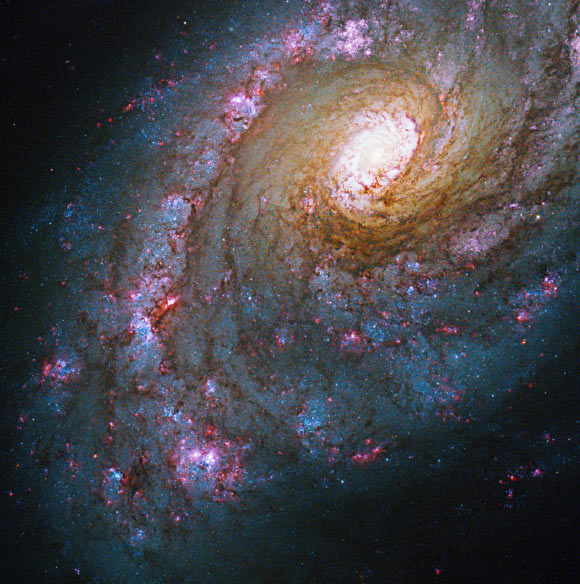NASA has released more than 50 new Hubble images featuring 30 galaxies, star clusters, and nebulae. All of these objects belong to a collection known to astronomers as the Caldwell catalog.

This Hubble images shows Caldwell 45, a spiral galaxy located 59 million light-years away in the constellation Boötes. Also known as NGC 5248, this galaxy is notable for the ring structure around its nucleus. These nuclear rings are characterized by hot spots of starburst activity. Caldwell 45 was discovered by astronomer William Herschel in 1784. The galaxy has an apparent magnitude of 10 and can be spotted using a small telescope, though it won’t appear very bright. A larger telescope is needed to make out the galaxy’s spiral arms. The best time of year to observe Caldwell 45 is during the northern hemisphere’s spring and the southern hemisphere’s autumn. This stunning image of Caldwell 45 is a composite of observations made by Hubble’s Wide Field Camera 3 (WFC3) and Wide Field and Planetary Camera 2 (WFPC2) in visible, infrared, and ultraviolet light. It captures the glowing red clouds where new stars are forming, scattered along the galaxy’s winding arms. These observations of Caldwell 45 were made to help astronomers learn more about gas in the galaxy’s starburst regions, as well as to better understand the structure of its nuclear rings. Image credit: NASA / ESA / J. Lee, California Institute of Technology / A. Filippenko, University of California, Berkeley / Gladys Kober, Catholic University of America.
During the 18th century, the French astronomer Charles Messier compiled a list of approximately 100 diffuse objects which were difficult to distinguish from comets through the telescopes of the day.
These smudgy spots on the sky have since been revealed as distant galaxies, star clusters, and nebulae, and his catalog became a guide for locating visually stunning cosmic objects.
In the 1980s, the British amateur astronomer and science communicator Sir Patrick Caldwell-Moore produced an additional list to highlight more cosmic wonders visible to amateur astronomers.
Unlike the Messier catalog, which only features objects that were visible from Messier’s viewing location in Europe, the Caldwell catalog includes celestial bodies that are found in both the northern and southern skies.
It consists of 46 star clusters, 35 galaxies, and 28 nebulae, or 109 objects in total.
Caldwell-Moore intentionally avoided including any of the Messier objects in his catalog, hoping to expand his fellow amateur astronomers’ cosmic horizons.
From nearby clouds of gas and dust that are left over from dying stars to remote galaxies that formed billions of years ago, the Caldwell catalog is brimming with surprising celestial treats.
The newly-released collection of more than 50 new Hubble images features 30 Caldwell objects.
“Because of Hubble’s detailed field of view, some of its pictures do not capture the entirety of a Caldwell object, sometimes instead zooming in on clusters of young stars in the arms of a spiral galaxy, stars on the outskirts of a cluster, or the zombie star at the heart of a nebula,” NASA astronomers said.
“But in other cases, a mosaic of Hubble observations assembles to create a complete or nearly complete portrait of the celestial marvel.”
Hubble’s collection now includes 87 of the 109 Caldwell objects.
“For each listing in Hubble’s Caldwell catalog, a basic star chart shows observers when and where they can find that object in the night sky, and a description suggests what type of observing equipment can be used to view it,” the researchers said.
“The individual articles also explain Hubble’s images for those who prefer to just enjoy the telescope’s exquisite views.”







